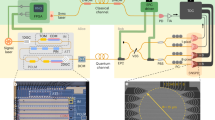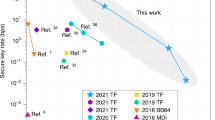Abstract
Quantum key distribution (QKD)1,2 offers a long-term solution to secure key exchange. Due to photon loss in transmission, it was believed that the repeaterless key rate is bounded by a linear function of the transmittance, O(η) (refs. 3,4), limiting the maximal secure transmission distance5,6. Recently, a novel type of QKD scheme has been shown to beat the linear bound and achieve a key rate performance of \(O(\sqrt{\eta })\) (refs. 7,8,9). Here, by employing the laser injection technique and the phase post-compensation method, we match the modes of two independent lasers and overcome the phase fluctuation. As a result, the key rate surpasses the linear bound via 302 km and 402 km commercial-fibre channels, over four orders of magnitude higher than existing results5. Furthermore, our system yields a secret key rate of 0.118 bps with a 502 km ultralow-loss fibre. This new type of QKD pushes forward long-distance quantum communication for the future quantum internet.
This is a preview of subscription content, access via your institution
Access options
Access Nature and 54 other Nature Portfolio journals
Get Nature+, our best-value online-access subscription
$29.99 / 30 days
cancel any time
Subscribe to this journal
Receive 12 print issues and online access
$209.00 per year
only $17.42 per issue
Buy this article
- Purchase on Springer Link
- Instant access to full article PDF
Prices may be subject to local taxes which are calculated during checkout



Similar content being viewed by others
Data availability
The data that support the plots within this paper and other findings of this study are available from the corresponding authors upon reasonable request.
References
Bennett, C. H. & Brassard, G. Quantum cryptography: public key distribution and coin tossing. In Proc. IEEE International Conference on Computers, Systems and Signal Processing 175–179 (IEEE, 1984).
Ekert, A. K. Quantum cryptography based on Bell’s theorem. Phys. Rev. Lett. 67, 661–663 (1991).
Takeoka, M., Guha, S. & Wilde, M. M. Fundamental rate-loss tradeoff for optical quantum key distribution. Nat. Commun. 5, 5235 (2014).
Pirandola, S., Laurenza, R., Ottaviani, C. & Banchi, L. Fundamental limits of repeaterless quantum communications. Nat. Commun. 8, 15043 (2017).
Yin, H.-L. et al. Measurement-device-independent quantum key distribution over a 404 km optical fiber. Phys. Rev. Lett. 117, 190501 (2016).
Boaron, A. et al. Secure quantum key distribution over 421 km of optical fiber. Phys. Rev. Lett. 121, 190502 (2018).
Lucamarini, M., Yuan, Z., Dynes, J. & Shields, A. Overcoming the rate–distance limit of quantum key distribution without quantum repeaters. Nature 557, 400–403 (2018).
Ma, X., Zeng, P. & Zhou, H. Phase-matching quantum key distribution. Phys. Rev. X 8, 031043 (2018).
Lin, J. & Lütkenhaus, N. Simple security analysis of phase-matching measurement-device-independent quantum key distribution. Phys. Rev. A 98, 042332 (2018).
Lo, H.-K., Curty, M. & Qi, B. Measurement-device-independent quantum key distribution. Phys. Rev. Lett. 108, 130503 (2012).
Hwang, W.-Y. Quantum key distribution with high loss: toward global secure communication. Phys. Rev. Lett. 91, 057901 (2003).
Lo, H.-K., Ma, X. & Chen, K. Decoy state quantum key distribution. Phys. Rev. Lett. 94, 230504 (2005).
Wang, X.-B. Beating the photon-number-splitting attack in practical quantum cryptography. Phys. Rev. Lett. 94, 230503 (2005).
Minder, M. et al. Experimental quantum key distribution beyond the repeaterless secret key capacity. Nat. Photon. 13, 334–338 (2019).
Liu, Y. et al. Experimental twin-field quantum key distribution through sending or not sending. Phys. Rev. Lett. 123, 100505 (2019).
Wang, S. et al. Beating the fundamental rate-distance limit in a proof-of-principle quantum key distribution system. Phys. Rev. X 9, 021046 (2019).
Zhong, X., Hu, J., Curty, M., Qian, L. & Lo, H.-K. Proof-of-principle experimental demonstration of twin-field type quantum key distribution. Phys. Rev. Lett. 123, 100506 (2019).
Yuan, Z. et al. Directly phase-modulated light source. Phys. Rev. X 6, 031044 (2016).
Comandar, L. et al. Quantum key distribution without detector vulnerabilities using optically seeded lasers. Nat. Photon. 10, 312–315 (2016).
Lipka, M., Parniak, M. & Wasilewski, W. Optical frequency locked loop for long-term stabilization of broad-line DFB laser frequency difference. Appl. Phys. B 123, 238 (2017).
Ma, X. & Razavi, M. Alternative schemes for measurement-device-independent quantum key distribution. Phys. Rev. A 86, 062319 (2012).
Zeng, P., Wu, W. & Ma, X. Symmetry-protected privacy: beating the rate–distance linear bound over a noisy channel. Preprint at https://arxiv.org/abs/1910.05737 (2019).
Zukowski, M., Zeilinger, A., Horne, M. A. & Ekert, A. K. Event-ready-detectors Bell experiment via entanglement swapping. Phys. Rev. Lett. 71, 4287–4290 (1993).
Briegel, H.-J., Dür, W., Cirac, J. I. & Zoller, P. Quantum repeaters: the role of imperfect local operations in quantum communication. Phys. Rev. Lett. 81, 5932–5935 (1998).
Acknowledgements
We thank H. Zhou for insightful discussions. This work was supported by the National Key R&D Program of China (2017YFA0303903), the Chinese Academy of Science, the National Fundamental Research Program, the National Natural Science Foundation of China (grants 11875173, 61875182 and 11674193) and Anhui Initiative in Quantum Information Technologies and Fundamental Research Funds for the Central Universities (WK2340000083).
Author information
Authors and Affiliations
Contributions
X.M., T.-Y.C. and J.-W.P. conceived the research. Y.-A.C. Q.Z., C.-Z.P., X.M., T.-Y.C. and J.-W.P. designed the experiment. X.-T.F., H.Liu and T.-Y.C. carried out the experiment. P.Z., W.W. and X.M. performed the protocol security analysis and data post-processing. M.Z. and Y.-L.T. assisted with the experiment scheme discussion and verification. Y.-J.S. designed and developed the voltage pulse generator. Y.X. programmed the field-programmable gate array logic. W.Z., H.Li, Z.W. and L.Y. designed and fabricated the superconducting nanowire single-photon detector. M.-J.L. and H.C. provided the ultralow-loss fibres. P.Z., X.-T.F., H.Liu, X.M., T.-Y.C. and J.-W.P. co-wrote the manuscript, with input from the other authors. All authors discussed the results and proofread the manuscript.
Corresponding authors
Ethics declarations
Competing interests
The authors declare no competing interests.
Additional information
Publisher’s note Springer Nature remains neutral with regard to jurisdictional claims in published maps and institutional affiliations.
Supplementary information
Supplementary Information
Supplementary Figs. 1–4, discussion, equations 1–28 and Tables 1–10.
Rights and permissions
About this article
Cite this article
Fang, XT., Zeng, P., Liu, H. et al. Implementation of quantum key distribution surpassing the linear rate-transmittance bound. Nat. Photonics 14, 422–425 (2020). https://doi.org/10.1038/s41566-020-0599-8
Received:
Accepted:
Published:
Issue Date:
DOI: https://doi.org/10.1038/s41566-020-0599-8
This article is cited by
-
Improving the performance of practical phase-matching quantum key distribution with advantage distillation
Quantum Information Processing (2024)
-
Complex quantum network models from spin clusters
Communications Physics (2023)
-
Tight finite-key analysis for mode-pairing quantum key distribution
Communications Physics (2023)
-
Twin-field quantum key distribution without optical frequency dissemination
Nature Communications (2023)
-
Hierarchical controlled remote preparation of an arbitrary m-qudit state with four-qudit cluster states
Quantum Information Processing (2023)



